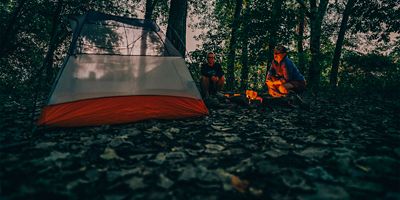Fall asleep to the sound of the ocean while nestled beneath oak trees dripping with Spanish moss at Stafford Beach Campground on Cumberland Island National Seashore. It’s the best of both worlds: acres of beautiful forest combined with 17 miles of tranquil, wild beach. The island—the westernmost point of shoreline on the Atlantic Ocean—is off the coast of Georgia and boasts almost 10,000 acres of wilderness. Camping at Stafford is like a mini-backpacking trip—you’ll walk about three miles one-way on the flat Parallel/Pratts Trail from the ferry dock to the cluster of 10 sites at Stafford Beach. From the campground, it’s just a few minutes’ walk through the forest to the beach, where you can catch a colorful sunrise. Keep your eyes peeled on the way—you might spot dolphins or wild horses.
While Cumberland Island is a wild place now, it has a long human history. Indigenous people inhabited the island as early as 2000 B.C. In more recent history, Spanish missions came to the island in the 1500s. They were followed, in the 1700s, by slavery and plantations. After the American Revolution, wealthy American families built mansions on the island. Evidence of this history can be seen in the local museums and relics from the past.
Getting There:
You’ll hop on the Cumberland Island Ferry from St. Marys, Georgia, which is about 40 minutes from the Jacksonville International Airport across the border in Florida.
Best Campsites:
Most of the 10 sites at Stafford are tucked into towering trees (great for hammocks and shade), but some are more private than others. All of the sites are a close walk to the beach and each one has a fire ring with a grill as well as a food storage locker. Up to six people can stay at a site ($12/night). You can see pictures of each site and reserve your favorite at Recreation.gov (you’ll need to make a ferry reservation too). We like sites 4, 5, and 6 because they offer a little more space between them than the others.
When To Go:
The campground is open year-round, but the most popular time to visit is during the spring and fall. If you’re planning to hike rather than swim, visiting during the spring/fall months will be more pleasant. Summers on the island are buggy and humid, but the warm temperatures are prime for swimming and the mosquitoes tend to avoid the beach. Winter is also great, with no crowds, no bugs, and average high temps in the mid-60s. Regardless of when you go, make campsite and ferry reservations well in advance.
Supplies:
BYO food and gear—the island has only water fountains and bathrooms. The campground itself has flush toilets, cold showers, and water spigots (treat this water before drinking). Campers can shop for food and last-minute supplies in the town of St. Marys before hopping on the ferry.




